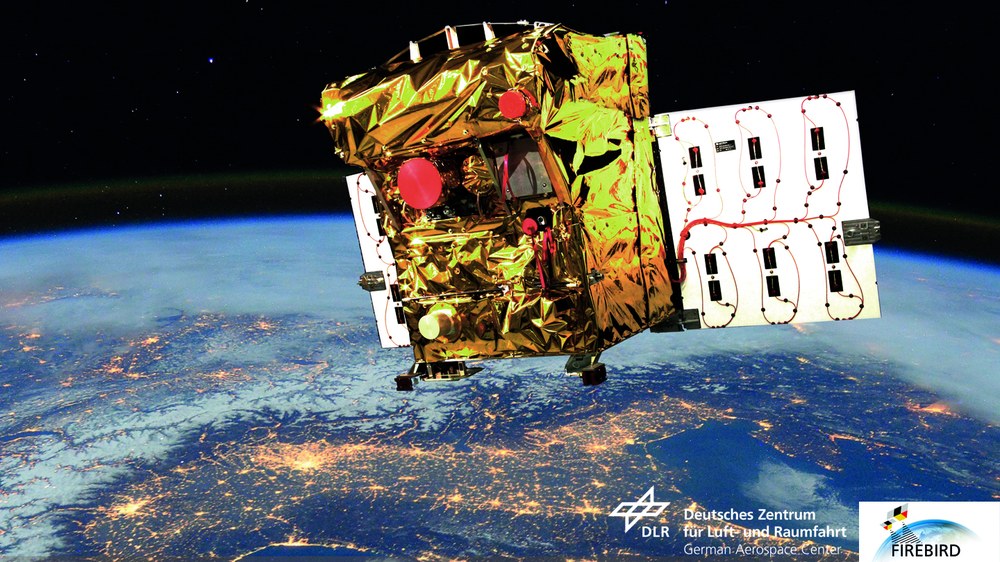FIREBIRD
FireBIRD is an earth observation mission and consists of two satellites, TET-1 and BIROS (Bispectral Infrared Optical System). They are both based on the small satellite BIRD (operational from 2001 to 2004), which was developed by the DLR Institute of Optical Sensor Systems. A similar system of infrared cameras is fitted to both of these satellites. TET-1 has been orbiting Earth since 2012, searching for fires and other high-temperature events. TET-1's 'brother', the small satellite BIROS, built in Berlin Adlershof, has also been in orbit since 2016, adopting an open constellation to support TET-1 on its important mission.

The satellite data is mainly received at the DLR ground station in Neustrelitz and then processed, archived and made available worldwide for scientific purposes by the German Remote Sensing Data Center (DFD). The FireBIRD satellites are operated and controlled by the German Space Operations Center (GSOC) within DLR's Space Operations in Oberpfaffenhofen.
Unlike other current satellites, FireBIRD has the capability to detect smaller fires in particular. This enables more precise mapping, and therefore analysis of their impact on the climate. Moreover, exact registration of forest and bush fires is highly relevant due to the economic loss they entail.
Construction of the BIROS satellite was funded by the German Federal Ministry of Education and Research (Bundesministerium für Bildung und Forschung; BMBF).
FireBIRD Recording Systems

The main payload is an infrared system consisting of three camera modules for quantitatively analysing high temperature events. The capabilities of the basic configuration were already confirmed in the BIRD mission. The camera system has three physically independent line scan cameras: one for the visible and near-infrared range and two cameras recording in the mid-infrared and longwave infrared ranges, each with its own power supply and command and data interfaces.
This guarantees functional independence in case one of the modules fails. It offers many possibilities to optimize various measurement tasks as well. For example, it is possible not to turn on the multi-function camera for night-time recording in order to relieve the power and thermal regime. Mechanically, all cameras are mounted on a common optical bench, which optimally supports the mutual alignments necessary for operations. The cameras are also coupled via internal interface circuitry so that they can be reciprocally synchronized. The circuits are passive when a module is not connected in order to preserve the principle of independence and to avoid error propagation.
Camera Parameters

VIS (three CCD lines FPA) | 2 IR Cameras (different spectral ranges) | |
|---|---|---|
Wavelengths | 0.5 µm, 0.6 µm, 0.8 µm green, red, NIR | MWIR: 3.4 - 4.2 µm LWIR (TIR): 8.5 - 9.3 µm |
Focal length | 90.9 mm | 46.39 mm |
Field of View | 19.6° | 19° |
F number | 3.8 | 2.0 |
Detector type | CCED linear array | CdHgTe linear array |
No of pixels | 3 x 5164 | 2 x 512 staggered |
Data quantization | 14 bit | 14 bit |
Ground pixel width | 42.4 m | 356 m |
Sample width | 42.4 m | 178 m |
Swath width | 211 km | 178 km |
In-flight calibration | None | Use of a movable calibration flap |
Satellites

As with the previous BIRD satellite, the primary payload of the FireBIRD mission on the TET-1 and BIROS satellites was developed at the DLR Institute of Optical Sensor Systems. It consists of a bi-spectral infrared sensor, which records signals in the mid- and thermal-infrared spectral ranges (3.4-4.2 microns and 8.5–9.3 microns). An additional camera records three channels in the range of visible light through near-infrared. The first FireBIRD satellite, TET-1, was launched on 22 July 2012 as part of the On Orbit Verification (OOV-TET) mission of DLR’s Space Administration Division. The second satellite, BIROS, is a copy of the TET-1 bus with construction financed by a grant from the Federal Ministry of Education and Research. At an altitude of approximately 570 km in sun-synchronous orbits the two satellites operate in a constellation which can be influenced to a certain extent by so-called “phasing” of BIROS. The purpose of FireBIRD is to explore and demonstrate the expanded possibilities offered by a satellite constellation for remotely sensing fires.
Downloads
- FireBIRD Flyer (5.5 MB)
